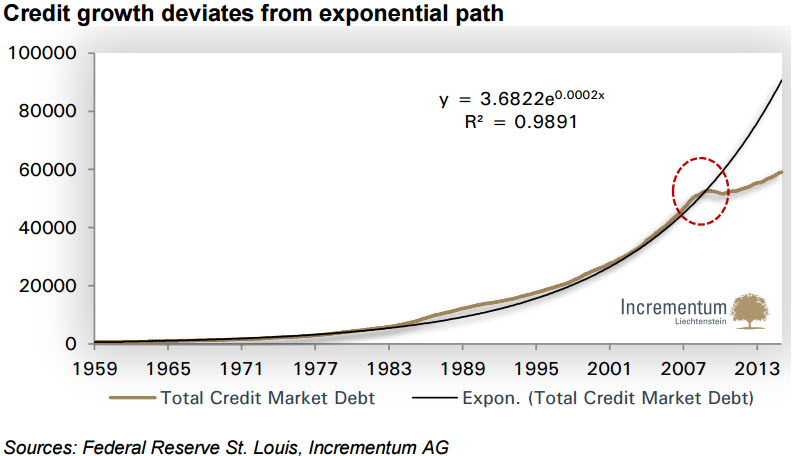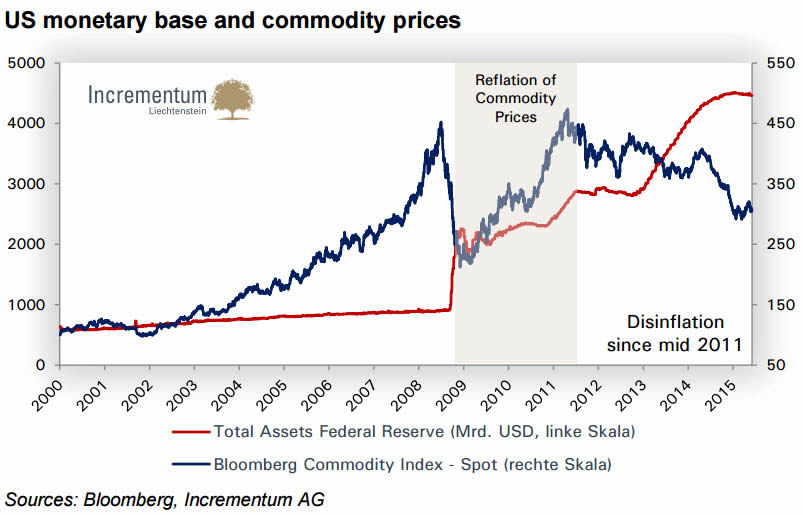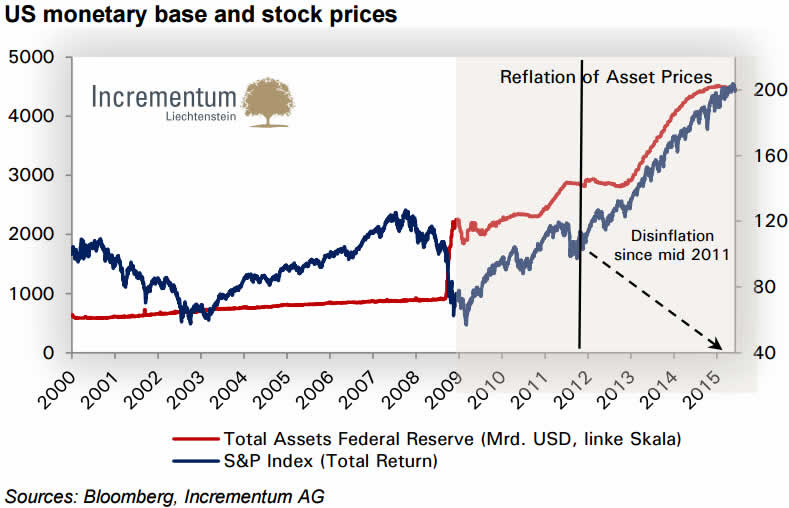In Gold We Trust 2015: Gold Remains In A Secular Bull Market
Commodities / Gold and Silver 2015 Jun 25, 2015 - 11:39 AM GMTBy: GoldSilverWorlds
 The ninth edition of In Gold We Trust is out. It is another outstanding, world class report full of unique insights for investors. In Gold We Trust 2015 is focused on the impact of the unusual montary policies on the financial system, investing, and precious metals. In sum, the debt problem is bigger than it seems, and it remains widely misunderstood. This report is a master piece in clarifying the future consequences of the huge global debt burden.
The ninth edition of In Gold We Trust is out. It is another outstanding, world class report full of unique insights for investors. In Gold We Trust 2015 is focused on the impact of the unusual montary policies on the financial system, investing, and precious metals. In sum, the debt problem is bigger than it seems, and it remains widely misunderstood. This report is a master piece in clarifying the future consequences of the huge global debt burden.
The report is written by Ronald Stoeferle who is the managing partner at Incrementum AG in Liechtenstein, and Mark J. Valek who is the founding partner and investment manager. They manage a global macro fund, focusing on a proprietary management approach, influenced by the Austrian School of Economics.
Summary of In Gold We Trust 2015
We have all become involuntary guinea pigs in an unprecedented monetary experiment, the economic (and sociological) outcome of which remains uncertain. Ever more frequently observable phenomena including asset price inflation, chronic over-indebtedness, extreme boombust cycles, but also the fragile interaction between inflation and deflation are symptoms of a problem with a systemic cause.
It seems obvious to us that the crux of the matter is the current inflationary uncovered debt money system. This system requires exponential inflation of the supply of money and credit. A consistent expansion of monetary aggregates in the traditional manner is no longer possible in the current phase. Consequently, the financial system finds itself in an increasingly unstable situation.

The endogenous addiction to money supply growth and rising prices is – especially in light of the over-indebtedness problem – a central pillar of our thesis that a turning point in the trend of price inflation is close. In the course of an interventionist spiral, ever more dubious measures are adopted by monetary authorities in order to force a reflation of the economy and higher rates of price inflation. These steps include interventions like quantitative easing, negative interest rates, financial repression and possibly even a cash ban.
In order to attain the well-known goal of achieving higher nominal growth, the method known as “GDP targeting” could eventually be employed. This allegedly innovative monetary policy endeavor is in reality nothing but old wine in new skins. Nominal growth is supposed to be fabricated – as this is no longer possible otherwise – by rising rates of inflation. Since real economic growth so far remains anaemic, rising price levels are supposed to create higher revenues for the State, in order to enable it to service its nominal interest obligations.
Even though we know of countless deterrent examples that show that such aggressive money supply expansion ends with “too high” price inflation, this dangerous gamble is being tried yet again. Inflationary policy is always a desperate attempt to create artificial prosperity by means of the printing press, which, as any objective assessment shows, will never be sustainable. The perpetuation of zero interest rate policy suspends the market’s self-healing corrective forces and fosters the nurturing of new asset bubbles. Following the technology and housing bubbles, we are once again right in the middle of another asset bubble. While the previous bubbles were focused on individual sectors or specific market segments, we are currently in the midst of an entirely different bubble dimension. Government bonds are at the center of the debt money system and represent the majority of the assets held by central banks and institutional investors. All available means will be exploited to prevent this bubble from bursting.
Gold has historically been the best hedge against such excessive inflationary efforts. Gold was and remains an outstanding pillar as a store of value and medium of exchange. These qualities are likely to be rediscovered if, or rather when, paper currencies suffer a general loss of confidence. Lengthy periods of rising price inflation and negative real interest rates are the main catalyst for such a loss of confidence.
The global race to debase currencies is progressing to the next round. It appears as though Japan has handed the baton to Europe now. The weak euro is likely to enter the history books as a Greek gift. We are convinced that gold will emerge as the victor in this ongoing devaluation competition.
Below we list the most important arguments in favor of investing in gold:
- Global debt levels are currently 40% higher than in 2007
- The systemic desire for rising price inflation is increasing
- Opacity of the financial system – volume of outstanding derivatives by now at USD 700 trillion, the bulk of which consists of interest rate derivatives
- Concentration risk – “too big to fail” risks are significantly higher than in 2008
- Gold benefits from periods of deflation, rising rates of price inflation and systemic instability
- Gold is a financial asset that has no counterparty risk
Relative to the monetary base, the gold price is currently at an all time low. In our opinion, this is a temporary anomaly, which we believe provides an extraordinarily favorable buying opportunity. Moreover, as we have demonstrated, gold is quite cheap relative to stocks and bonds, but also relative to a number of hard assets. As a result, widespread assertions that gold continues to be exorbitantly overvalued are not tenable.
From a technical perspective, the overall picture is not unequivocal. On the one hand, the downtrend that has been in force since 2011 hasn’t been broken yet. On the other hand, negative sentiment indicates widespread resignation and capitulation by gold bulls. Moreover, seasonality and the fact that gold stocks are extremely oversold relative to gold, is giving us further confidence. CoT data were up until recently still negative, but have improved considerably in the meantime. Only in silver the set-up in futures markets positioning still looks negative. Given that silver often provides reliable signals for gold price trends, we consider a final selloff – possibly in connection with a rate hike in the US – to be possible. In the course of this, the support at USD 1,140 could be tested or even breached in the short term. A reversal following such a retest would be a reliable technical signal of a primary turning point in the gold market.
In the context of this environment, we remain more strongly convinced than ever, that gold stocks represent an interesting, if highly volatile, investment opportunity. Creative destruction in the sector is normal and healthy in the long term. In the course of the market adjustment, mining company managements have set new priorities, with profitability, capital spending discipline and shareholder value having replaced the maximization of gold production. Moreover, there is probably no other sector that is viewed with more skepticism by investors at present.
Based on the “big picture” analysis that is packed into this report, we see no reason for a change of course: In gold we (still) trust. We are strongly convinced that gold remains in a secular bull market, which is close to making a comeback. Should our assumption be correct, we expect to see a final trend acceleration at the end of the cycle. We believe the time has come for us to provide a concrete time horizon in addition to our long-term price target. In light of the outlook discussed above, we have have set a time horizon of three years (June 2018), to reach our long-term price target of USD 2,300.
We don’t believe this is the right time to warn of the great dangers associated with investing in gold. The potential for setbacks has historically been higher in times of high price inflation rates, from which we obviously remain far away (for the time being). Even if one does not share our bullish assessment, an overly critical attitude towards any gold investment whatsoever in our opinion displays ignorance of monetary history.
Gold Price Forecast
We have discussed in detail that the debt situation in many regions of the world is unsustainable. The idea that “growing out” of overindebtedness would be possible, is in our opinion a highly unrealistic expectation, as there is no realistically achievable combination of tax rates and growth rates in most countries that would allow for a sustainable reduction of the extant debt burdens.
A consistent, drastic austerity policy shouldn’t be expected either. Southern European countries are an example showing the democratic limits with respect to austerity policies. Zero interest rate policies are a major pillar supporting high debt ratios and are even increasing the incentive to amass additional debt.
A debt haircut by a major industrialized nation is unthinkable, as the deflationary follow-on effects would be too dramatic in today’s highly interrelated financial system. The only politically palatable path is a flight forward: Aggressive re-inflation of the economy is intended to make debt burdens sustainable by increasing nominal prices. Note in this context the example of Japan, which has progressed the furthest in terms of indebtedness.
The economic cycle appears quite mature by now. After 2008, money supply inflation has been employed in unprecedented fashion in order to artificially boost the economy. Especially the increase in economic activity in the US in recent years is attributable to the illusion of growing prosperity through the so-called “wealth effect”.

This can be illustrated by dividing the reflationary trend after 2008 into two segments: pre and post 2011.

While from 2008 to 2011 the prices of both stocks and commodities (and thus the prices of real assets) were driven higher, a disinflationary trend in commodity prices can be discerned since 2011. Since then, money supply inflation primarily induced financial asset price inflation. This phase has culminated in a disinflationary tsunami in 2014. A strengthening US dollar exerting deflationary effects once again delayed the probability of a rate hike and left the much-desired zero interest rate environment in place, benefiting stock markets.
We are strongly convinced that we are now close to a fork in the road. Over the coming three years, a paradigm change is likely to become evident in the markets, quite possibly including rising inflationary trends. We believe the following scenarios to have the highest probability:
Scenario I: The current economic cycle nears its end and the fairy tale of a self-sustaining recovery is increasingly questioned by market participants. This leads to a significant devaluation of the US dollar relative to commodities, since the Fed – as it has stressed time and again – will once again employ quantitative easing or similar interventions if occasion demands it. In this case gold would benefit significantly from wide-ranging repricing in financial markets. A stagflation-type environment would become a realistic alternative in this scenario, something that is currently on almost no-one’s radar screen.
Scenario II: Rising yields lead to an increase in credit creation and an increase in money velocity (= decline in the demand for money). Economic activity picks up, is however accompanied by accelerating price inflation.210 In this scenario, both financial assets (with the exception of bonds) and real assets (such as gold) would benefit in nominal terms.
Scenario III: The system hasn’t become any healthier since 2008, but has in fact become more fragile in many respects. Due to further concentration in the banking sector, the balance sheets of the largest banks have grown enormously. The volume of outstanding derivatives has continued to grow, with many off-balance sheet positions. In addition, the geopolitical situation hasn’t been this tense since the end of the cold war. The probability of a “black swan” event striking is therefore in our opinion higher than it has been in a long time. In this type of scenario, gold would likely emerge as a beneficiary as well.
Conclusion: All in all we are convinced that gold remains in a secular bull market, which is likely close to a renaissance. Should this assessment be correct, we would expect to see a trend acceleration in the coming phase. As discussed above, a variety of scenarios is possible which would mostly have positive effects on the gold price. We believe that this is a good time to provide a concrete time horizon for our long ago formulated price target. In light of the perspective discussed above, we have decided to set a time horizon of three years for our long term gold price target of USD 2,300.
Read the full report
Incrementum Liechtenstein AG | Email: contact@incrementum.li
Source - http://goldsilverworlds.com/
© 2015 Copyright goldsilverworlds - All Rights Reserved Disclaimer: The above is a matter of opinion provided for general information purposes only and is not intended as investment advice. Information and analysis above are derived from sources and utilising methods believed to be reliable, but we cannot accept responsibility for any losses you may incur as a result of this analysis. Individuals should consult with their personal financial advisors.
© 2005-2022 http://www.MarketOracle.co.uk - The Market Oracle is a FREE Daily Financial Markets Analysis & Forecasting online publication.



